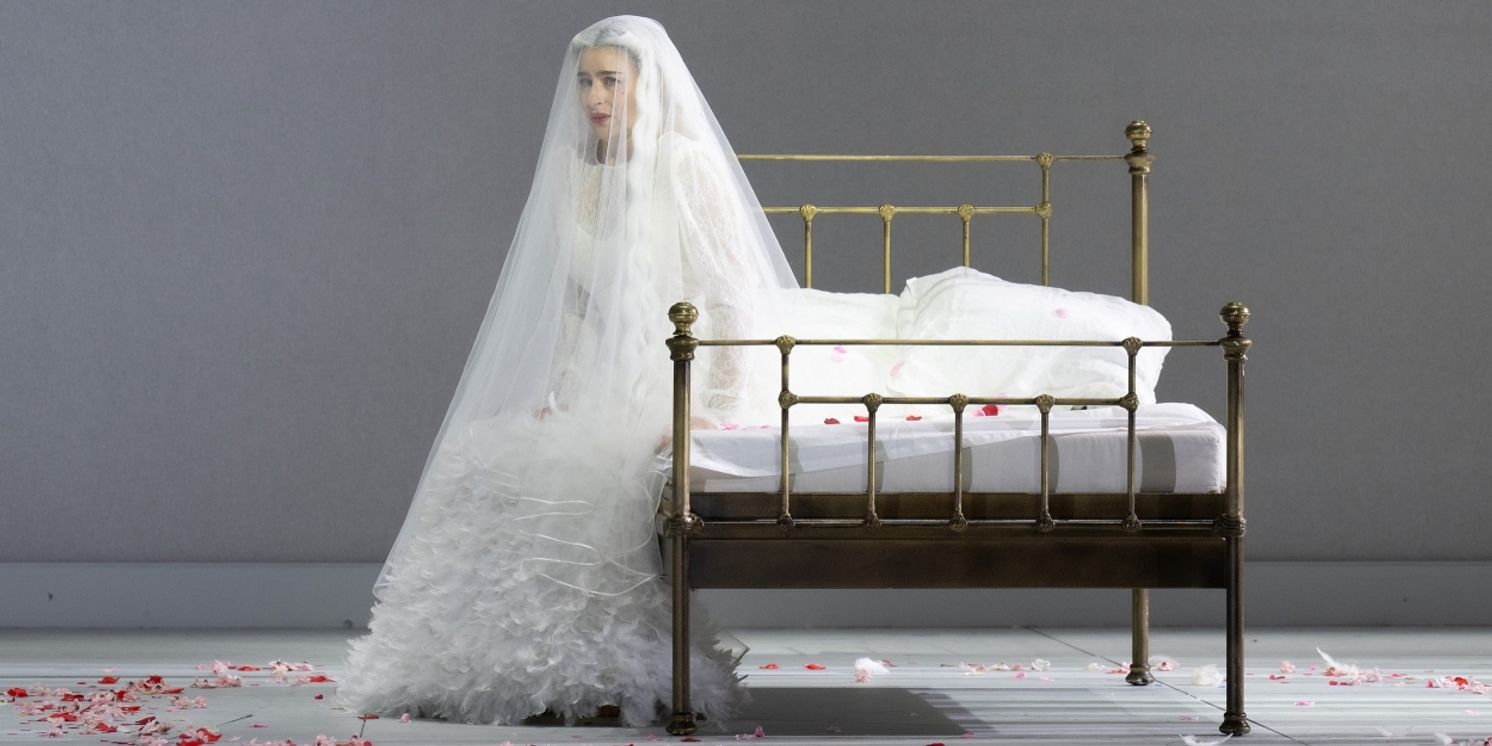Review: In Freud's Vienna, Grigorian Thrills as Anguished TURANDOT under Kober
Paired with Exciting Tenor Gyngazov, in Guth Production at Vienna State Opera

Perhaps it’s only fitting in a town that’s known for art, music and psychoanalysis (and maybe a little whipped cream on the side), that the Vienna State Opera’s production of Puccini’s TURANDOT—with the stunning soprano Asmik Grigorian in the title role—features a traumatized characterization of the title role, with the fine Russian tenor Ivan Gyngazov as Calaf.
Conceived by director Claus Guth for Grigorian’s debut in the role last year, you might call this the “anti-Zeffirelli” view of the opera, with its spare setting from Etienne Pluss, video by Rocafilm/Roland Horvath and carefully created lighting by Olaf Freese. The wonderful Vienna State Opera chorus, under Martin Schebesta, is front and center at the start of the piece, though it doesn’t stay there for long, giving the proceedings a more intimate feel than many of us are used to seeing with this opera.
If you didn’t follow along with the translation, you might not have realized that the opera takes place in China, even a Westerner’s misguided view of it, though Puccini’s lush score brings in its Eastern (or pseudo-) motifs. In fact, Turandot herself has long, flowing blonde hair, hardly typical of the setting.
In all, there’s very little in the way of chinoiserie in what we see on stage: That is, unless it was supposed to take place during the bureaucratic rule of Chairman Mao, with the chorus dressed by Ursula Kudrna in sickly green costumes befitting the communist era. This includes the Ping-Pang-Pong characters, bureaucrats all, well sung by baritone Martin Hassler and tenors Norbert Ernst and Hiroshi Amako, who are frequently portrayed in an over-the-top manner, but are more low key here.
After the opera’s plot is introduced through an announcement to the people of “Peking,” Turandot is found in her bare bedroom in the palace, where she’s dressed like a bride, surrounded by her four life-sized dolls, as another would-be suitor has lost his battle of wits with her and has been beheaded. This is where we are given some indication by the director that there is a backstory about the princess’s youth that deals with the trauma she may have had at the hands of her father Emperor Altoum (tenor Jorg Schneider).
Act II, the opera’s centerpiece, has the thrilling aria "In questa reggia" ("In this palace") in which Turandot tells of her ancestor, Princess Lou-Ling, who she believes now lives within her. She reigned over her kingdom, resisting the domination of men, until she was raped and murdered by an invading foreign prince.
Turandot has vowed never to marry—and has contrived a trio of supposedly unanswerable riddles designed to send any suitor to his death. Calaf (tenor Gyngazov) ruins her plans by answering them correctly. The scene between Grigorian and Gyngazov, where he is grilled by her, is more tension-filled than usual, thanks to the tenor’s acting and vocal skills (though no one would mistake him for an Italian) and Grigorian’s underplayed, wisely calculated performance. He gives her one last chance to avoid marriage—to discover his heretofore secret name--and the opera’s best-known aria, “Nessun dorma” (“No one sleeps”), gets an earnest, well-sung rendition from Gyngazov, as Turandot’s minions try to discover it.
This is the first revival of the production since its premiere last winter, where Grigorian also sang the title role, which is most often sung by big-voiced sopranos—not how Grigorian is most often described—and she seems no worse for wear from doing a role that some might have thought was a bit too strenuous for her. But she’s a game performer (as she proved in a wildly varied recital a week earlier) whose acting is as thoughtful as her vocalism. From her first notes, in “In questa reggia,” we know that this going to be something different and it is. No ice princess from her, but a wounded soul whose three riddles are meant to protect herself, not simply outsmart her suitors.
While this take on the opera is more intimate than what we may be used to seeing, it’s nonetheless rich in characterizations all the way through, till Turandot and Calaf run off into the sunset, leaving the royal court without a future monarch. Guth has chosen to place extra emphasis on Turandot, giving the role of Liu, the slave of Calaf’s father, Timur (bass Dan Paul Dumitrescu), short shrift; this seems rather unfortunate since soprano Kristina Mkhitaryan showed off a lovely instrument.
TURANDOT has been known as a “problem” opera since its debut because Puccini didn’t live to finish it. What to do, what to do? Toscanini stopped the premiere when he reached the last notes composed by Puccini, even though Franco Alfano, chosen by the composer’s heirs to complete the work, had produced an ending that was subsequently performed. He then produced a second, shorter version of the ending, which has left many dissatisfied. Today, composers are still producing new endings for the work, including one by composer Christopher Tin and librettist Susan Soon He Stanton that recently premiered by Washington National Opera in Washington, DC.
Nonetheless, the company’s “pit band”—better known as the great Vienna Philharmonic Orchestra—under Maestro Axel Kober, did a sublime job of the score, using the first, and longer, ending that Alfano devised from the notes left by Puccini and not often heard today.
Photo: Asmik Grigorian as Turandot
Credit: © Monika Rittershaus and © Wiener Staatsoper
TURANDOT performances will continue through January. For more information, please see the English language version of the Vienna State Opera’s website.
Reader Reviews
Videos

